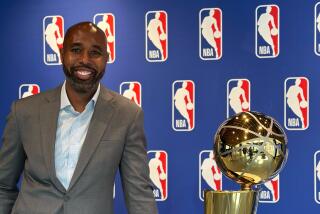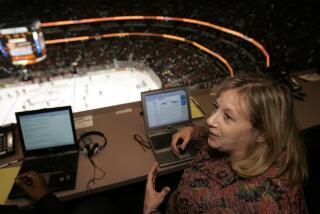Unseld Teaches Ellison Facts of NBA Life
- Share via
WASHINGTON — The Education of Pervis Ellison continued recently in the equipment room at Capital Centre. It’s a tiny room, but with more than enough space for Coach Wes Unseld to make a point.
It was after the Knicks had beaten the Bullets, and after Patrick Ewing dominated Ellison, establishing position offensively and defensively.
The final numbers read: Ewing, 24 points, 19 rebounds, 3 blocks. Ellison had 17, 12 and 5. That kind of production from a center would have been cause for jubilation a couple of years ago. Now, it was a disappointment.
“Everybody had left the locker room,” Ellison recalled. “Coach called me in there. He said ‘Pervis, I think you were a little hesitant in the game. When you’re out there on the floor, don’t try to be the best player on the floor, be the best player at your position.’ That’s what he wants from each player on the floor.
“So I went home and I watched the films. ... And sure enough, even (television analyst) Phil Chenier said it. ... Two people have seen the same thing. They’ve got to be right. And when I was watching the film I could see times when I wasn’t real intense at all on the offensive end.”
The coach sees it. The player does it. That’s the symbiosis that is happening now between the 6-foot-11 Ellison and his 6-7 wall of a coach. From the mind of Unseld, who lived in the NBA lane for 13 years, comes praising and cajoling and occasional screaming at the young man who gives away 30 or so pounds in the pivot nearly every night.
From Ellison, a variety of unique skills at both ends of the floor allow him, even as he struggles to stay above 210 pounds, to be the only center in the league to stay with The Big Three -- Ewing, Olajuwon, Robinson -- among league leaders in scoring, rebounds and blocked shots.
He’s averaging 20.8 points on 53 percent shooting from the floor, and 12.4 rebounds. It was just two seasons ago that Darrell Walker led Washington in rebounding. No Bullets center has averaged 12 rebounds a game since Jeff Ruland’s 12.3 in 1983-84.
He is currently second, behind Ewing, in the voting for center on the Eastern Conference all-star team. Should the former Louisville star make the squad, it would cement an incredible turnaround for the first pick of the 1989 draft, who was booed roundly at ARCO Arena by Kings fans while struggling through an injury-plagued first season.
Much has been accomplished in Ellison’s first full year as a starter, but nothing was more important to Unseld than his demeanor and approach.
The coach was as angry as he gets when Ellison took in the sights of Los Angeles last season instead of getting ready to play the Lakers. The player never forgot the message.
“What I wanted Pervis to do was give the game the respect that it’s due,” Unseld said.
That means watching film. It also means giving yourself an extra hour of rest on the road, and eating right, and thinking about the opposition. And if Unseld is hard on Ellison, perhaps it’s because he knows he has one of the new prototypes in the league, a lanky big man who can play either power forward or center in the right system -- meaning, with a 240-pounder playing next to him.
There is something special about a big man in pro basketball. He gives his team legitimacy. The cliche about a little man not being able to dominate in the NBA has lasted so long only because it’s basically true.
And there’s something else. Wilt Chamberlain said nobody loves Goliath. There are different responsibilites for seven-footers and their ilk. Unlike some of their teammates, there’s no chance they can walk through an airport without someone knowing their occupation, if not their name.
“Pervis recognizes his uniqueness, and he carries himself very well,” Unseld said. “But on the court we talk about a lot of things.”
There were, and are, so many things. It took Unseld and assistant coaches Bill Blair and Jeff Bzdelik months to pound it into Ellison to keep the ball high overhead when rebounding, so that gnat-like guards can’t swipe it away from below.
They had to pare some of his desire to pass first. No one wants a selfish player, but there’s room on the Bullets for some aggressive offensive talents.
Yet now, with Ellison’s success, comes the expected adjustments from the opposition, which has begun to double-team him. Though he’s an excellent passer for a big man, it’s still an adjustment for him to find the open player -- and for his teammates to react to it and find the open spots on the floor.
Ellison isn’t grabbing a dozen rebounds a game because he attacks the basketball, like Charles Barkley. He is aided by long arms, even by NBA standards, and a quick “second jump,” which is the player’s ability to get off the ground again after landing.
It also requires a willingness to take chances with one’s body. Try this: Jump as high as you can. Now do it again, only have someone shove you sideways as you do it. Now do it again, and get shoved, and try to catch a basketball about eight feet in the air at the same time.
That’s NBA rebounding, multiplied by about three times the weight and two times the height.
Unseld can appreciate the uncertainty of leaving the ground, only to wind up three or four feet from where you jumped.
“There are no easy nights for a center,” he said.
More to Read
Go beyond the scoreboard
Get the latest on L.A.'s teams in the daily Sports Report newsletter.
You may occasionally receive promotional content from the Los Angeles Times.










